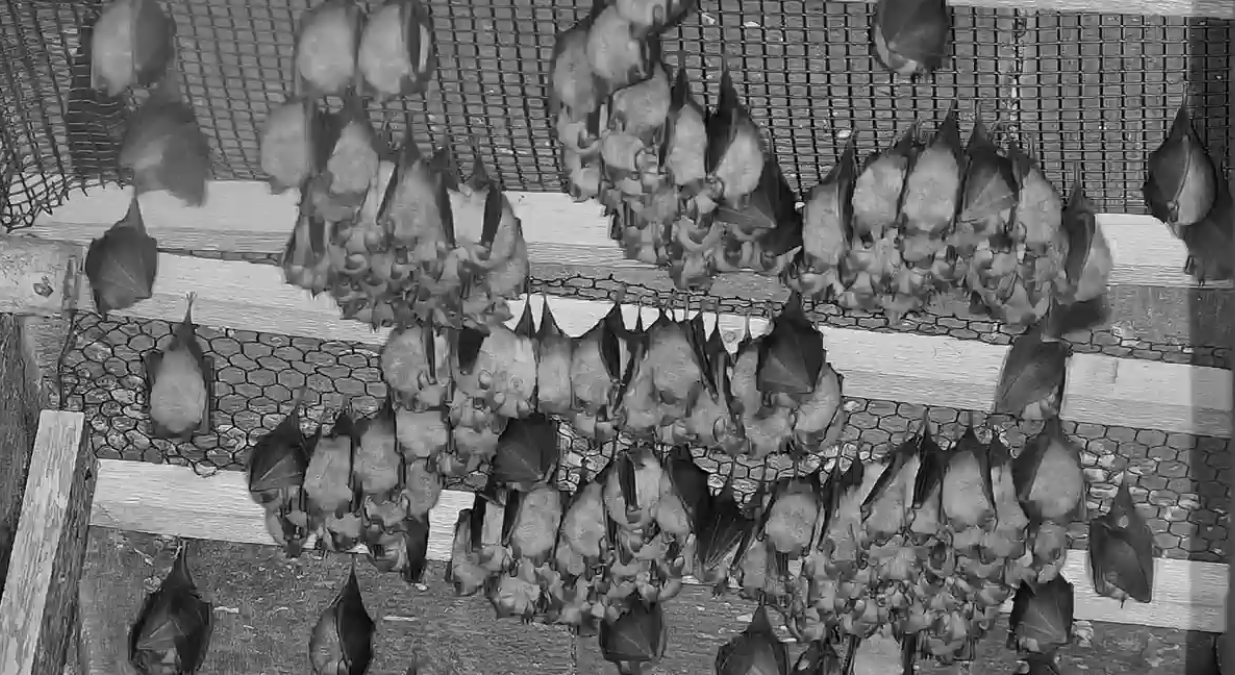This is a live view of lesser horseshoe (Rhinolophus hipposideros) bats at a roost within Clwyd. During the summer the view is of the maternity roost, while during the winter the view is of hibernating bats in a separate part of the same building. The roost is a Site of Special Scientific Interest for the species and the camera helps us to monitor the colony.
We are investigating embedding the live feed in our site, however, if you click on the picture below it will take you to the live feed!
Note: The view is sometimes blurred by bat urine on the camera! The video is currently limited by slow internet speeds but we are working to improve this, as a result the feed occasionally drops so keep refreshing your screen if its not working!
This is project is kindly sponsored by Natural Resources Wales and South Lancashire Bat Group.
The lesser horseshoe bat is one of the smallest British species, being around plum-sized. At rest it hangs with the wings wrapped around the body . Like the greater horseshoe bat, it has a complex noseleaf which is related to its particular type of echolocation system.In the summer lesser horseshoe bats emerge about half an hour after sunset. The emergence follows a period when the bats fly around within the roost with some appearing outside the roost entrance; presumably they are testing the conditions outside before emergence. Although there are peaks of activity at dusk and dawn bats are active all night throughout the breeding season. Lesser horseshoe bats are sensitive to disturbance and twist their bodies as they scan their surroundings before flying off. Lesser horseshoe bats feed amongst vegetation in sheltered lowland valleys. They rarely fly more than five metres above the ground, frequently circling over favoured areas and often gleaning their prey from branches. Large prey is often taken back to a temporary night roost or sometimes dealt with whilst the bat is hanging in trees. Feeding remains are often found in these temporary night roosts, particularly in porches and the entrance to tunnels. Lesser horseshoe bats were originally cave dwellers, but summer colonies are now usually found in the roofs of larger rural houses and stable blocks offering a range of roof spaces and a nearby cellar, cave or tunnel where the bats can go torpid in inclement weather. They prefer access through an opening that allows uninterrupted flight to the roof apex but are capable of using more inconspicuous gaps. The colony may shift between attics, cellars and chimneys throughout the summer, depending on the weather. The whole colony may form a dense cluster, especially in cooler weather during lactation but if the roost gets very hot individuals hang spaced slightly apart. Lesser horseshoe bats hibernate from September/October until April and frequently into May, using caves, mines, tunnels and cellars. Lesser horseshoe bats are often active in hibernacula in autumn and spring, especially towards dusk in warm weather, when feeding is more likely to be successful. They appear to select places with similar temperatures to those sought by greater horseshoe bats, preferring temperatures of up to 11ºC and high humidity. Males tend to arrive earlier than females and are often more numerous. Many sites only have one or a few bats hibernating in them and it is rare to find large numbers in a site. Lesser horseshoe bats do not cluster together but hang a little apart form their neighbours, usually in exposed situations, but sometimes in open crevices. They may be found at any height, venturing much further into underground sites than other bats. Flies (mainly midges), small moths, caddis flies, lacewings, beetles, small wasps and spiders. Mating takes place during autumn, sometimes later in winter. Maternity roosts are almost always formed in buildings and may be occupied from April, though most breeding females do not arrive until May. Maternity colonies of the lesser horseshoe bat are mixed-sex, with up to a fifth of the colony being male. Approximately half to two-thirds of the females in the nursery roost give birth to a single young between mid-June and mid-July. Lactation probably lasts four to five weeks, by which time the young can fly from the roost. Young are completely independent at six weeks. Most young are sexually mature in their second autumn.


